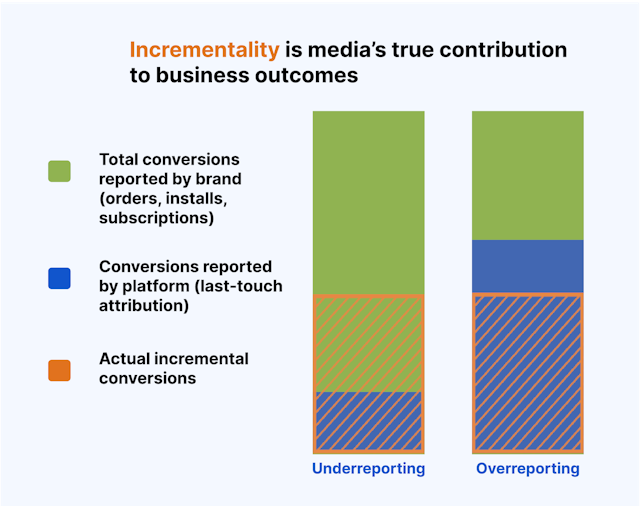How to advertise in the most confusing recession ever
Predicting shopper behavior during times of economic uncertainty is always a challenge for consumer brands, but the unique nature of the current recession is making budget planning especially difficult for marketers right now.

Effective optimization requires an accurate ongoing understanding of cross-channel media performance
While inflation is up in most markets, the UK unemployment rate remains the lowest it has been since 1974, and reports from the US suggest consumer spending hasn’t even begun to slow down. These contradictions – and mixed messages from economic experts about what to expect going forward – have many marketers rethinking their growth strategies.
When businesses brace for a potential drop-off in revenue, the common course of action is to reduce advertising spend across the board – but a less obvious strategy might be the smarter play. Making sweeping budget cuts in an effort to save money risks turning off marketing activities that could still be profitable. If consumers are still making and spending money, marketers need to optimize, rather than cut, investments in the media channels and tactics that produce the highest return on ad spend (ROAS).
Advertisement
Media strategy cannot be planned in the dark
Effective optimization requires an accurate ongoing understanding of cross-channel media performance. To maximize efficiency, media should be continually optimized whenever something related to the business or advertising performance changes. Comparing quarter-by-quarter results is simply too slow in a world where we have seen three different British prime ministers in two months.
To compound the issue, increased data-privacy regulations and tracking restrictions have wreaked havoc on attribution and conversion reporting by digital ad platforms. (Was it ever wise to let them grade their own homework, anyway?) Significant gaps in user-level data mean measurement methods such as last-touch and multi-touch attribution, which require tracking IDs or the cobbling together of user click-paths, cannot be trusted to inform business-critical decisions about media investments.
Marketers are in the dark at the worst time ever – in the midst of a global financial crisis and heading full speed into the busiest shopping season of the year. If forecasts are questionable and attribution results are unreliable, where should advertisers turn in the most confusing recession ever?
Incrementality insights can reveal the way forward
Most buyers encounter a brand at multiple touchpoints along the path to conversion. The myth that marketers have long been sold is that they need to know who converted, and every ad they saw leading up to the conversion, in order to measure how each ad performed. The reality is that all you need to know is what conversions would not have happened if you took a particular ad or channel away. That tells you the incremental conversions that are a direct result of the ad you removed, or the media incrementality.
Unlike modeling or click-based attribution methods, only incrementality connects media spend directly to business results. Media incrementality can be measured without user-level tracking, through cohort-based test and control experiments that are applied to first-party or geo-matched market audiences. Understanding the incrementality of each channel, tactic, or adset enables marketers to see exactly where spend is being wasted and identify where they could get more return.
Advertisement
Incrementality testing was actually the gold standard of advertising measurement before the world came online. Back then, designing and running experiments at scale required a lot of resources and a lot of money. It didn’t take much to distract everyone away with the promise of easy and cheap measurement on digital platforms. But now, as outdated attribution methods collapse, we’ve come full circle.

Experiments still work, but they’re even more complicated than before
As Meta recently acknowledged, only testing can validate the true contribution of advertising. The challenge for marketers today, with so many channels and hundreds of data sources, is deploying controlled experiments in a sound, scaleable and repeatable way. At Measured, we have spent years developing data science and technology to automate the complex experiment designs required for the nuances of every platform. Our goal is to make it easy for any business to grow through the power of incrementality.
Since 2017, we have executed thousands of experiments to assess the incrementality of every critical marketing channel and tactic by observing their contribution to actual sales transactions. Brands can use the Measured platform to run in-market experiments of their own, or to merely tap into the industry’s largest collection of incrementality intelligence for insights that provide immediate ways to optimize and validate their media investments.
Whether it’s a global pandemic or a baffling recession, uncertainty is certain. And when there are more questions than answers about the future of business, the ability to connect ad spend directly to business results can turn marketers into superheroes. It’s what the industry’s been seeking for decades. It’s the power of incrementality.
Suggested newsletters for you
Content by The Drum Network member:

Measured
Measured is the only incrementality intelligence platform that enables consumer brands to validate, plan and optimize media investments based on their true contribution...
Find out more
